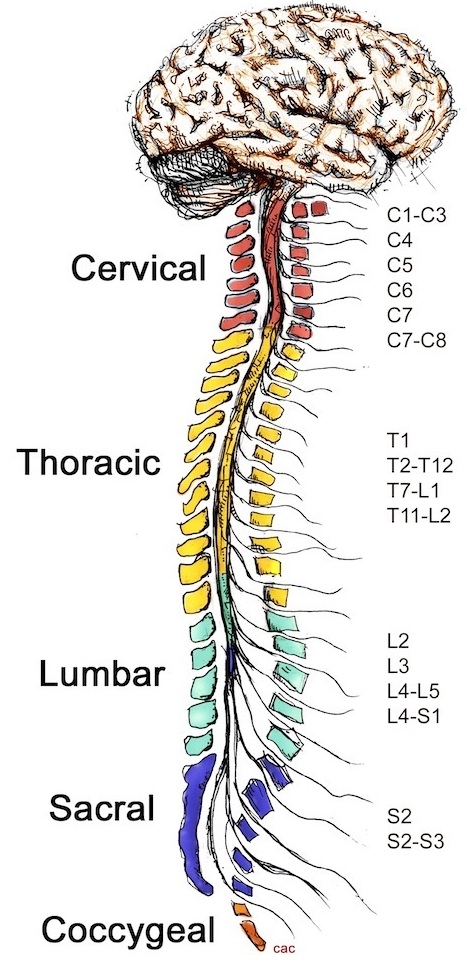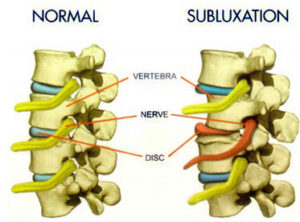Vertebral Subluxation
The Central Nervous System Is Your Lifeline To Health
This page is designed to help you understand more about your Central Nervous System (the Brain and Spinal Cord). The Brain and Spinal cord are critical to your health and this report will show what devastating effects abnormal position of the spine and subluxation (neurological stress patterns) may have if left unattended.
Ignoring symptoms of the Central Nervous System may result in significant suffering, disease, and most of the unnecessary conditions that affect everyday life. All healing and body functions are coordinated by the Central Nervous System. Brain impulses travel down through the spinal cord to the rest of the body, communicating with your organs and muscles, instructing them what to do and how to function and heal. Damage caused by stress, tension, and pressure to the nerves causes faulty communication, which in turn will cause the organs to malfunction and healing to be delayed (or in some cases stop altogether). This damage will totally devastate your present and future health and wellbeing.
The spine houses and protects your Central Nervous System. Research shows the most common and likely way to interfere and damage the nervous system is if the spine moves out of NORMAL position or alignment (subluxation – see above). Abnormal spine movement, alignment and subluxation compression will stretch and/or twist the Central Nervous System.
The only healthy path is correction of subluxation and healing of the nervous system and spine. Through Chiropractic adjustments, stress will be cleared from the nervous system & the spine will be moved back into its healthy position which restores and optimizes your overall health. Chiropractic care will drastically reduce the likelihood of severe illness or disease from developing.
What Is A Subluxation?
Your body is able to accomplish so much during the day, without you having to think about it. Digestion, breathing, filtering blood, keeping your heart beating, just to name a few. Your brain coordinates and controls the show. Your brain is brilliant at adapting to the world. However sometimes, the stresses and traumas can be overwhelming to your brain and body. Slips, falls, emotional stress, car collisions, sports injuries, poor posture, bad sleeping habits, stress at work, childhood falls and the birth process itself can all create stress in the body.
When overwhelmed, the nervous system will “blow a fuse”. Over time, when the fuses stay blown your body can become stuck in survival mode. The “blown fuses” are called subluxations: A misaligned spinal bone (vertebrae) causing compression, tension, irritation, & damage to the Central Nervous System (brain, spinal cord, & nerves).
If you interfere with the signals traveling over nerves, parts of your body will not be able to function at 100% , causing your organs, muscles, & immune system to malfunction and heal poorly. Chiropractors locate, reduce or correct them through the chiropractic adjusting process.
Subluxations are really a combination of simultaneous changes. These changes occur both in your spine, nervous system, and throughout your body. For this reason, they are called the “Vertebral Subluxation Complex”, or “VSC”. The VSC has 7 components:
- The Tone Component consists of the overall tone, or functional state, of the nervous system. Think of the VSC’s as a “blown fuse” in the nervous system. Over time, these “blown fuses” cause the nervous system to shift and become stuck in survival mode. This component is also known as dysautonomia.
- The Meningeal Component is when the connective tissue surrounding the spinal cord and brain becomes twisted or torqued. Originally mapped out by Alf Breig, MD, this torque alters the function of the entire CNS. This component is known as adverse mechanical cord tension.
- The Nerve Component is the malfunctioning of the nerve. Research has shown that only a small amount of pressure on spinal nerves can have a profound impact on its function. This creates negative feedback to the brain, creating imbalance. This is known as neuropathology, disconnection & dysafferentation.
- The Osseous (bone) component is where the vertebrae are misaligned, moving poorly, or are undergoing physical changes such as degeneration. This component is known as kinesiopathology or dyskinsis.
- The Muscle Component is also involved. Since the muscles help hold the vertebrae in place, and since nerves control the muscles themselves, muscles are an integral part of any VSC. In fact, muscles both affect, and are affected by the VSC. This component is known as myopathology.
- The Soft Tissue Component is when changes occur to the surrounding soft tissues. Tendons, ligaments, fascia, blood supply, and other tissues undergo changes: either at the point of the VSC or far away. This component is also known as histopathology.
- The Chemical Component is when all these components of the VSC are acting on your body, and therefore causing some degree of chemical changes. These chemical changes can be slight or massive depending on the location & severity. This component is often known as biochemical abnormalities.
Chiropractors have known about the dangers of subluxations for over one hundred years. Today, more scientific evidence is showing the health benefits of correcting them. To be truly healthy, it is vital that your nervous system be functioning free of interference from subluxations. Our intention is to allow your body to access the highest level of health possible by clearing the neurospinal system. Chiropractors are the ONLY health professionals trained in the detection, location, and correction of the VSC.
Subluxation Degeneration
Subluxation causes changes to the structure, as well as the function of the nervous system. These changes are known as “Subluxation Degeneration.” By understanding the type and amount of changes, it’s possible to reasonably estimate the time subluxations have been present, and the time and effort needed for correction. When subluxations are left uncorrected, ongoing relentless changes occur, damaging the structure of the spine and nervous system.
Near Normal: This is a side x-ray view of the neck. As with all the pictures on this page, the patient is looking to the right, so you are viewing the right side of their neck. This picture is a “near normal” spine. Notice the normal forward curve of the neck. This curve helps absorb shock. Each of the disc spaces between the vertebra are thick and even. The front portions (right on the x-ray) of each vertebrae (called the ‘body’ of the vertebrae) are fairly square, with clear, well defined borders. Normal vertebrae in other parts of the spine have similar characteristics.
Phase One Subluxation Degeneration is seen when subluxations that have been present for up to twenty years. This phase is characterized with a loss or change in the normal curve in the spine. The normal forward (lordotic) curve is lost. This spine even has developed a reverse curve. The disc spaces have also begun to change shape. The bodies of each of the vertebrae still have clean clear borders. Segmental motion may be abnormal but overall motion is probably not affected. Chiropractic care for a phase one can take from 6 to 18 months. More than 80% of people with Phase One have no pain. If left uncorrected, phase one continues to progress.
Phase Two Subluxation Degeneration is normally seen when subluxations have been present 20-40 years. This phase has the same characteristics as phase 1, as well as altered segmental motion. Phase 2 many times shows a reduction in overall range of motion.. X-rays begin to show calcium changes or buildup. These changes are sometimes called spurs and arthritis. Disc spaces between are noticeably narrower and may be “flattening out”. Although most people with Phase Two may not exhibit any symptoms, some may start to feel stiff or achy. Chiropractic care ranges from 1.5 years to 2.5 years. Again, if left uncorrected it slowly advances to the next phase.
Phase Three Subluxation Degeneration is caused by subluxations present for 40-65 years. This phase has all of the attributes of the previous phases, only worse. The curvatures are abnormal; the disc spaces are vastly decreased and changed. Calcium changes on the spine are abundant. Normally, people have a restricted range of motion and probably exhibit symptoms of some kind. Bone “spurs or lipping,” can be readily seen on x-ray. Chiropractic care for patients ranges from 2.5 years to 3.5 years.
Phase Four Subluxation Degeneration is seen when subluxations have been raging uncorrected for decades. This negatively affects longevity and quality of life. The massive amounts of neurological damage are probably taking a serious toll on the person’s health status. X-rays show severe structural changes. Vertebrae exhibit massive calcium changes, disc spaces appear blurred, and the bones themselves appear fused. There will be severe restriction of range of motion in addition to probably a number of other health issues. Complete restoration may not be possible, but care can be directed to reduction in subluxation to improve quality of life. People in Phase Four have a serious situation (structurally & neurologically) but they are certainly not beyond hope. Many people report significant improvements in symptoms, conditions, mobility, and quality of life.
It should be noted that the above are common guidelines and not hard rules. Every person is dynamic and different. People degenerate at different rates. The further along your spine may be with Subluxation Degeneration, the more strenuous and time consuming your road to improvement will be. For this reason we always stress early care to stop and prevent the advancement of Subluxation Degeneration. Of course, if you’re not under chiropractic care, the best time to start is NOW!

